RetroLisa
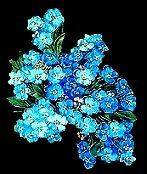 | 1910s
Music & Entertainment
part 1 | |
|
___________________________________________________________________________________________________________
|
|
|
RetroLisa
| ___________________________________________________________________ | __ | _____________________________ | _______ | Music Charts
1910
• Down By The Old Mill Stream - Arthur Clough & Brunswick Quartet
-------------------------------Harry MacDonough
• Mother Machree - Will Oakland
--------------------John McCormack
• Come, Josephine, In My Flying Machine - Ada Jones & Billy Murray
-----------------------------------------Blanch Ring
• Let Me Call You Sweetheart - Peerless Quartet
• Chinatown, My Chinatown - American Quartet
• I'd Love To Live In Loveland (With A Girl Like You)
• He's A College Boy - Billy Murray
• Casey Jones - Billy Murray & American Quartet
• Put Your Arms Around Me, Honey - Collins & Harlan
• Carrie, Carrie, Marry Harry - Billy Murray
• Where The River Shannon Flows - Harry MacDonough
• Play That Barbershop Chord - Bert Williams
1911
• Alexander's Ragtime Band - Collins & Harlan
• Oh, You Beautiful Doll - Billy Murray & American Quartet
• Memphis Blues - W.C. Handy
• Everybody's Doing It Now
• I Want A Girl (Just Like The Girl That Married Dear Old Dad)
• My Melancholy Baby
• I Don't Believe You - Ada Jones & Billy Murray
• Missouri Joe - Sophie Tucker
• Just Before The Battle, Mother - Stanley & Burr
• Billy (She Always Dreams Of Bill) - American Quartet
• The Red Rose Rag - Billy Murray
• Under The Yum Yum Tree - Collins & Harlan
• Some Of These Days - Sophie Tucker
1912
• Frankie & Johnny - John Hurt
• Be My Little Baby Bumblebee - Ada Jones & Billy Murray
• Moonlight Bay - American Quartet
• The Sweetheart Of Sigma Chi
• When Irish Eyes Are Smiling - Chauncey Olcott
• Waitin' On The Levee - Bob Roberts
• The Preacher & The Bear - Arthur Collins
• Silver Bell - Ada Jones & Billy Murray
• When The Midnight Choo Choo Leaves For Alabam' - Collins & Harlan
• When I Lost You - Henry Burr
• I Love You Truly - Elsie Baker
• Love Is Mine - Enrico Caruso
1913
• The Curse Of An Aching Heart
• If I Had My Way
• You Made Me Love You - Helen Clark & Walter Van Brunt
--------------------------Al Jolson
• Ballin' The Jack - Princes Orchestra
• He'd Have To Get Out & Get Under (To Fix Up His Automobile) -
-------------------Billy Murray
-------------------Bobby North
-------------------Al Jolson
• Melinda's Wedding Day
• Danny Boy
• Peg O' My Heart - Charles Harrison
• Waiting For The Robert E. Lee - Al Jolson
---------------------------------Heidelberg Quintet
• Trail Of The Lonesome Pine - Henry Burr & Albert Campbell
1914
• Twelvth Street Rag
• St. Louis Blues - W.C. Handy
• By The Beautiful Sea - Ada Jones & Billy Watkins
------------------------Heidelberg Quintet
• Down Among The Sheltering Palms
• Goodbye, My Lady Love
• Chicken Reel - Edward Meeker
• Where Did Robinson Crusoe Go With Friday On Saturday Night
• When You Wore A Tulip
• Fido Is A Hot Dog Now - Billy Murray
• The Suffragette Waltz
• Sweet Kentucky Lady
• Aba Daba Honeymoon - Collins & Harlan
1915
• The Sunshine Of Your Smile
• Alabama Jubilee
• Are You From Dixie?
• I Love A Piano - Billy Murray
• M-O-T-H-E-R (A Word That Means The World To Me) - Henry Burr
• Father's Old Red Beard - May Irwin
• Paper Doll
• Nola
• I've Been Floating Down The Old Green River - Billy Murray
• The Little Ford Rumbled Right Along - Billy Murray
• Auntie Skinner's Chicken Dinner - Collins & Harlan
• Cotton Blossom Time - Collins & Harlan
• Carry Me Back To Old Virginny - Alma Gluck
• Hello, Frisco - Olive Kline & Reinald Werrenrath
• Gasoline Gus & His Jitney Bus - Billy Murray
1916
• Pretty Baby - Billy Murray
• If You Were The Only Girl In The World
• My Little Girl
• Roses Of Picardy
• On The Old Dominion Line
• Do What Your Mother Did - Sterling Trio
• Since Mother Goes To Movie Shows - Peerless Quartet
1917
• Oh Johnny, Oh Johnny, How You Can Love! - American Quartet
• The Darktown Strutters' Ball - Original Dixieland Jass Band
-------------------------------Arthur Collins
• Livery Stable Blues - Original Dixieland Jass Band
• Back Home Again In Indiana
• For Me & My Gal - Van & Schenck
• Smiles - Joseph C. Smith's Orchestra
• Poor Butterfly - Victor Military Band
• Star Spangled Banner - John McCormack
• Till The Clouds Roll By - Anna Wheaton & James Harrod
1918
• Ja-Da
• Rock-A-Bye Your Baby With A Dixie Melody - Al Jolson
• After You've Gone - Marion Harris
• Beautiful Ohio - Waldorf-Astoria Dance Orchestra
-----------------Henry Burr
• I'm Always Chasing Rainbows - Charles Harrison
• K-K-K-Katy - Billy Murray
• Tiger Rag - Original Dixieland Jass Band
• The Daughter Of Rosie O'Grady
• Somebody Stole My Gal
• Hindustan
• I'm Sorry I Made You Cry - Henry Burr
• My Mammy - Al Jolson
1919
• Wifey Is A Real Suffragette
• The Vamp
• The World Is Waiting For The Sunrise
• How Ya Gonna Keep 'Em Down On The Farm (After They've Seen
Paree) - Nora Bayes
• A Pretty Girl Is Like A Melody - John Steel
• A Good Man Is Hard To Find - Bessie Smith
• Peggy
• Alice Blue Gown - Edith Day
• I'm Forever Blowing Bubbles - Albert Campbell & Henry Burr
------------------------------Ben Selvin & His Orchestra
• Let The Rest Of The World Go By - Albert Campbell & Henry Burr
• Wait Till You Get Them Up In The Air, Boys - Billy Murray
• Mandy (There's A Minister Handy)
• Oh! What A Pal Was Mary - Henry Burr
• Mammy O' Mine
• Oh! By Jingo (Oh By Gee, You're The Only Girl For Me) - Premier Quartet
• Sahara, We'll Soon Be Dry Like You
• Tulip Time
• It's Nobody's Business But My Own - Bert Williams
| | |
_____________________________________________________________
|
|
|
RetroLisa
| ___________________________________________________________________ | __ | _____________________________ | _______ | Musical Trends
songs about World War I
In the late 1910s, the war in Europe occupied everyone's thoughts. Many songs were written about patriotism, military life, and the sadness felt by those left at home.
• Would You Rather Be A Colonel With An Eagle On Your Shoulder (Or A Private With A Chicken On Your Knee?)
• Till We Meet Again - Albert Campbell & Henry Burr
----------------------Charles Hart & Lewis James
----------------------Nicholas Orlando's Orchestra
• Hello Central, Give Me No-Man's Land - Al Jolson
• Sister Susie Sewing Shirts For Soldiers
• Pack Up Your Troubles In Your Old Kit Bag -
------------------------Oscar Seagle & Columbia Stellar Quartette
------------------------James F. Harrison & Knickerbocker Quartet
------------------------Helen Clark
------------------------Murray Johnson
------------------------Reinald Werrenrath
• Keep The Home-Fires Burning ('Till The Boys Come Home) -
------------------------John McCormack
------------------------James F. Harrison
------------------------Stanley Kirby
• Good Morning, Mr. Zip-Zip-Zip
• Oh! How I Hate To Get Up In The Morning -
------------------------Arthur Fields
------------------------Eddie Cantor
• Over There - Nora Bayes
---------------Enrico Caruso
---------------Billy Murray
---------------American Quartet
---------------Peerless Quartet
• It's A Long Way To Tipperary - John McCormack
--------------------------------American Quartet
• Hinky Dinky Parlez-Vous
• A Battle In The Air - Peerless Quartet
• The Ragtime Volunteers Are Off To War - Arthur Collins
• Goodbye Broadway, Hello France
• I'd Like To See The Kaiser With A Lily In His Hand
• General Pershing Will Cross The Rhine
• The Dixie Volunteers - Premier Quartet
-----------------------Eddie Cantor
• I'd Feel At Home If They'd Let Me Join The Army - Billy Murray
• Just A Baby's Prayer At Twilight For Her Daddy Over There - Henry Burr
• I Didn't Raise My Boy To Be A Soldier - Morton Harvey
---------------------------------------Peerless Quartet
• War Babies - Al Jolson
• Tell That To The Marines - Al Jolson | |
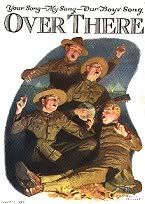
"Over There" was written by Broadway showman George M. Cohan. Like most songs of the era, it was recorded by several artists, including Nora Bayes and Enrico Caruso. Caruso also performed the song at Liberty Bond rallies.
|
| ________________________________________________ | ___ | ______________________________________________ | ________ | songs about airplanes & automobiles
It's easy to see why our imaginations were captivated by the airplane and automobile in the 1910s. The first airplane passenger services and airmail routes were established during this decade, and the automobile finally became affordable for the average consumer. Many songs were written about these two new methods of transportation. While a good share of them poked fun at the Model T, most dealt with the pleasures and challenges of taking your sweetheart for a ride.
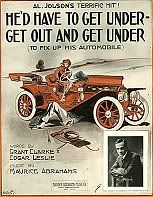
A dozen times they'd start to hug and kiss,
And then the darned old engine, it would miss.
And then he'd have to get under,
Get out and get under,
And fix up his automobile.
| |
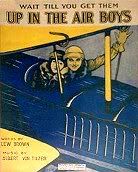
You can make them hug and squeeze you, too.
For if they don't, just say you won't
Come down until they do.
You can loop-the-loop till she can hardly get her breath.
It isn't hard to reason with a girl who's scared to death!
Wait till you get them up in the air, boys.
Up, up, up, up, way up in the air.

Come Josephine, in my flying machine.
Going up she goes, up she goes! |
| _________________________________________________________________ | __ | _______________________________ | _______ | popular music
The music we enjoyed in the 1910s covered a wide range of topics. Romantic ballads, sentimental parlor songs, and patriotic ditties tugged at the heartstrings. Comic selections made fun of prohibition, suffrage, various ethnic groups, and modern life in general. Nostalgia for the sunny south and the rolling hills of Ireland was also very common.
Coon songs depicted black people in an extremely negative and racist manner. They were popular from the 1880s to the 1910s, and were written and performed by both black and white artists. Despite its derotagory nature, this musical style was instrumental in paving the way for black musicians and black music in general. In the 1910s, coon songs fell out of favor when various groups began to speak out against them and legitimate black music gained a foothold in popular culture.
ragtime
This musical style featured a syncopated melody played over a steady bass line. Ragtime evolved from the cakewalks and minstrel tunes of the 1890s.
There were two types of rags: piano rags and dance rags. Piano rags were generally played live or sold as piano rolls, while dance rags were performed by small bands and recorded on cylinders or discs. In New York City, the music houses of Tin Pan Alley were a prime source for ragtime songs.
opera
The popularity of opera during this decade is a direct result of the popularity of the phonograph. All across the country, people who had never set foot in an opera house became fans when they listened to Enrico Caruso and Nellie Melba on their victrolas.
jazz
Jazz was born in New Orleans in the 1890s. It spread to a wider audience in the 1910s when southern jazz bands performed on Mississippi riverboats. In the late 1910s, the style became popular all across the country when these bands made the move to northern cities like Chicago and New York.
In 1917, the Original Dixieland Jass Band made the first jazz recording, "Livery Stable Blues". The term jazz was new, and an official spelling hadn't been established yet. Consequently, during this time it was spelled either jass, jas, or jazz.
| |
American Music Goes To War
Origins Of Ragtime
The Music Of Al Jolson
Pre-1920 Jazz Standards
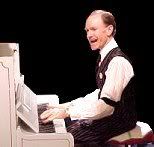

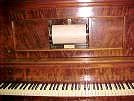
|
____________________________________________________________
|
|
|
RetroLisa
| ________________________________________________ | ___ | ______________________________________________ | ________ | For The Record

multimedia collections
general audio
Diamond Disc Recordings
World War I Vintage Media
UCSB Cylinder Recordings
music
Ragtime MIDIs
MIDI Jukebox
Turtle's 78 RPM Jukebox
Sophie Tucker Recordings
comedy
Uncle Josh Sample Recordings
Cohen On The Telephone
Uncle Josh Recordings
Golden & Hughes Recordings

| |
comedy recordings
Between the 1890s and 1920s, comedy recordings were immensely popular. They were also very offensive by today's standards. They got their laughs by making fun of immigrants, country bumpkins, and black people. The speech patterns of Jews and Irish immigrants were lampooned in dialect comedies, and blacks were the subjects of coon songs.
• Uncle Josh: Cal Stewart portrayed Uncle Josh Weathersby from 1897 until his death in 1919. Listeners loved his humorous tales about life in Punkin' Center and his adventures in the big city. Typical titles included "Uncle Josh Buys An Automobile", "Uncle Josh In A Department Store", and "County Fair At Punkin' Center".
• Cohen: In 1913, Joe Hayman made the first Cohen recording...."Cohen On The Telephone". This comedy skit depicted a man with a heavy Yiddish accent struggling to be understood on the phone. During the 1910s and 1920s, several actors made Cohen records. In most of the skits, poor Cohen was trying to talk to someone on the phone. Titles included "Cohen At The Movies" and "Cohen Phones The Gas Company".
• Golden & Hughes: The comedy team of Billy Golden and Joe Hughes specialized in skits and humorous songs delivered in black dialect. In the 1910s, titles included "An Easy Job On The Farm", "Hotel Porter & The Traveling Salesman", and "Darky School Days".
singles
Edison Blue Amberol Releases
|
| _____________________________________________________________ | __ | ___________________________________ | _______ | recording formats
In the 1910s, there were two types of records: cylinders and discs. Cylinders were introduced in the 1870s and discs in the 1880s. Until the 1900s, both formats were equally popular.
After peaking in 1907, the cylinder industry began to fall behind. There were several reasons for this. Cylinders had their limitations when it came to sound quality and recording time. They occupied a lot of storage space, contained only a single recording, and were prone to shrinking and cracking.
Discs had longer playing times and could be manufactured in many sizes. Each disc contained two recordings and featured lateral-cut grooves for better sound quality. They were also easier to store.
| |
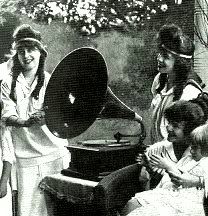 |
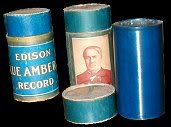
cylinders
In the 1910s, standard cylinders were made of hard black wax or celluloid. They contained either two or four minutes of material and were played at 160 RPM. Extra-wide Edison Concert cylinders were made of brown wax and featured a larger recording surface for better volume and sound quality. They were available until 1912.
Some cylinder formats were already obsolete by the 1910s. They included the wider concert-sized records from the 1900s and all brown wax records made before 1903. Most people kept their collection of obsolete cylinders, which could still be played on phonographs with older reproducers.

The proper way to
hold a cylinder record
| |
two-minute moulded black wax
• Edison Standard
• Pathe
• Edison Bell
• Clarion
four-minute moulded black wax
• Edison Amberols
• Edison Grand Opera Amberols
extra-wide brown wax
• Edison Concert Records
celluloid
• Indestructible Record Company
• U-S Everlasting
• Lakeside
• Columbia Gold Moulded Indestructible
• Oxford
• Edison Blue Amberols
• Edison Concert Blue Amberols
• Edison Royal Purple Amberols
• Edison Bell Indestructible |
discs
Most discs were made of shellac. 78 RPM was the standard recording speed, although speeds ranging from 76 to 82 RPM weren't uncommon. All discs were double-sided, with the exception of Victor Red Seal records and a few minor labels.
Standard records came in three sizes: 7, 10, and 12 inches. 7-inch records contained up to three minutes of material per side. They were never as popular as the larger records, and were being phased out during this decade. 10-inch and 12-inch records contained up to five minutes of material per side. Pathe, Emerson, and Operaphone discs were available in all sorts of unusual sizes.
Most records could be played on any standard phonograph. A handful of labels used specialized grooves that required a diamond or sapphire stylus, and could only be played on phonographs designed for them.
For a short time in the 1910s, the miniature record was a fad. These discs had an average width of five inches. They cost less than standard records, but also had shorter playback times and poor sound quality.
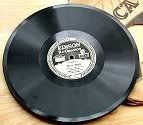
In 1912, Edison finally admitted that discs were superior to cylinders. He introduced the Edison Diamond Disc, which was thicker than a regular record and made of condensite plastic. These records required a diamond stylus and could only be played on the Edison Diamond Disc phonograph or a standard phonograph with an adaptor.
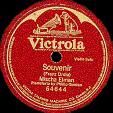
"Victor Red Seal Records: a Sign
of Taste and Refinement"
Red Seal records were one-sided and featured
classical and operatic performances
| |
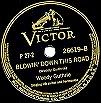
standard discs
• Victor
• Columbia
• Odeon
• Okeh
• Vocalion
• Gennett
• Oxford
• Silvertone
• Harmony
• Imperial
• Climax
• Zonophone
• Clarion
• Lakeside
• Edison Diamond Discs (1) (2)
miniature & other sizes
• Little Wonder
• Emerson
• Operaphone
• Majestic
• Pathe

|
____________________________________________________________________
|
|
|
